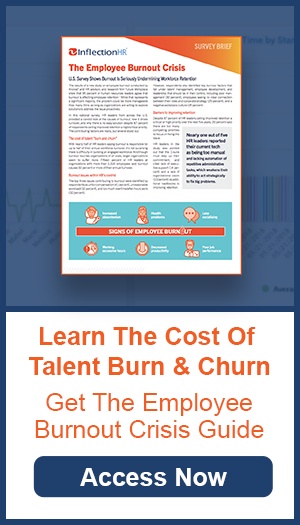Employee burnout is one of the most important barriers on employee engagement and retention.
In fact, a national study on employee burnout conducted by Kronos® and Future Workplace (an HR advisory and research firm) showed that 95% of human resource leaders agree that employee burnout affects employee retention. Employee burnout is also the cause of more than 50% of workforce turnover each year, with larger businesses and organizations suffering the most.
While there are many things that you could start doing today to help with employee retention and employee engagement, addressing how burnt out your employees are will help the long term productivity and engagement in your workforce. To find out if your business is suffering from employee burnout, download this Employee Burnout Crisis Survey Brief from InflectionHR.
Many Issues Fueling Employee Burnout Are In HR’s Control.
Too much work and too little pay are problematic but...
- Unfair compensation , unreasonable workload , and too much overtime / after-hours work are the top three contributors to employee burnout
- HR leaders also identified key employee burnout factors falling under talent management, employee development, and leadership that should be in their control
- Insufficient technology for employees to do their jobs was identified as one of the primary cause of employee burnout
- Insufficient Technology is more prevalent at larger organizations with over 2500 employees
Combating Employee Burnout
While not all employee burnout can be eliminated, much of it can be avoided using strategies such as:
- Balancing a consistent and personalized schedule against workload
- Leverage managers as models of how their team can achieve work/life balance
- Implement tools and technology that proactively manage employee burnout or otherwise support these efforts.
Employee Burnout Is Not The Only Barrier On Employee Engagement And Retention
Despite 87% of HR leaders calling improved retention a critical or high priority over the next five years, 20% said there are too many competing priorities to focus on fixing the issue.
The C-Suite must step up their commitment too according to HR leaders in the study. Lack of executive support and a lack of organizational vision are additional obstacles to improving retention.
Despite well documented costs of employee burnout and turnover, organizations are more apt to invest in recruiting new employees as opposed to retaining existing talent.
97% of HR leaders have worked to increase their investment in recruiting technology from where it was in 2017, including 22% who anticipate a 30% to 50% increase in such spending. However, budget was continually cited by HR leaders as a deterrent to programs that would benefit retention of existing talent. This includes:
- 16% who say a lack of budget is the primary obstacle to improving employee retention and preventing employee burnout
- 15% who say a lack of funding is the biggest challenge to improving employee engagement
- 27% who say funding is the biggest hurdle to implementing new HR-related technology, such as tools that would reduce manual or administrative work, which in turn reduce employee burnout
Today's HRMS solutions make it easy, and getting these tools into place place can be done with little effort assuming the HR team has a trusted HCM solution and partner in their bench that is committed to their success.


